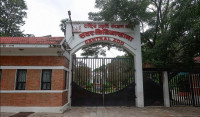Valley
Contrary to KMC claims, several roads in Valley remain waterlogged
Inundation of roads in the Valley during heavy rains will cease to be a menace this monsoon thanks to the construction of new gutters, a metropolitan official said
Traffic in Kathmandu has to wade through waterlogged streets during monsoon every year due to the dilapidated drainage system, ill-planned road development and lack of maintenance. Roads especially in Jamal, Putalisadak, Maitighar, Tripureshwor, Tinkune and Maitidevi are flooded immediately after heavy showers.
Officials say the problem is unlikely to persist this year. According to Engineer Ram Bahadur Thapa of the Kathmandu Metropolitan City, new and efficient drainage systems have already been built for discharging accumulated water in Jamal and Maitidevi while drainage construction is in the final phase at Putalisadak.
Underground systems have been built to release water from Jamal to Tukucha and from Maitidevi to Dhobi Khola, Thapa said, adding that Putalisadak will soon get respite as a sewerage system will shortly be completed in the nearby Bagbazaar.
“Unlike in the past when flooding stayed for days, water should not accumulate in these areas for more than a couple of hours now,” Thapa said. The Juddha Fire Brigade backs his claim. In the previous years, the KMC frequently sought the help of the brigade to clear water from several public places. This year it was not called for its services, said Kishor Kumar Bhattarai, chief of the Fire Brigade.
“We use light pumps to drain water more than a feet deep,” said Bhattarai. “Last year, we cleared areas around Bir Hospital, Jamal, New Road Gate, Tripureshwor and Putalisadak. This year, there has been no need to drain any place so far.”
Bhattarai, however, clarified that reopening of clogged roads is not their mandate and waterlogged ways sometimes impede their own firefighting operations.
Meanwhile, flooding in Tinkune and Maitighar looks set to continue for the time being. Officials said Maitighar has to wait for new drainages until the expansion of the Maitighar-Tripureshwor road is over. Likewise, the drainage capacity of the Tinkune road section, which was built with a Japanese assistance, is inadequate and needs overhauling for a long-term solution. Earlier this month, the Prime Minister’s Office directed the Department of Roads to immediately clean gutters that are clogged with dirt and to enhance the capacity of the existing system.
Experts blame the flooding on design flaws of city roads, alleging that drainage—a major component of roads, is often overlooked. Engineer Sunil Rai said that due to the topography of Kathmandu, gradient of roads needs to be maintained so that water flows to the drains and not sideways. Also, Rai said roads should incorporate the factor of superelevation—the amount by which the outer edge of a curve on a road is banked above the inner edge—which is absent from the roads here.




 20.15°C Kathmandu
20.15°C Kathmandu











